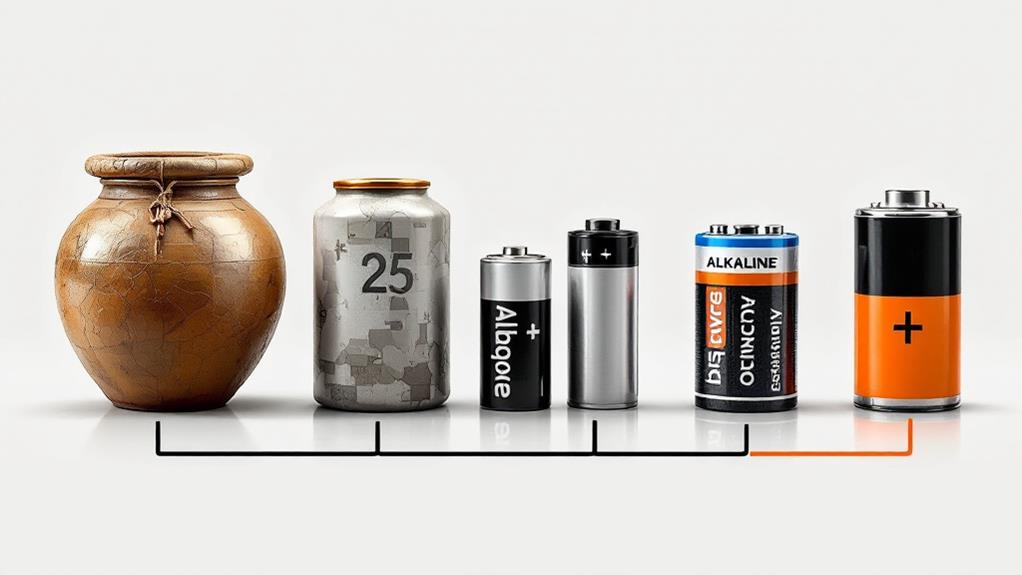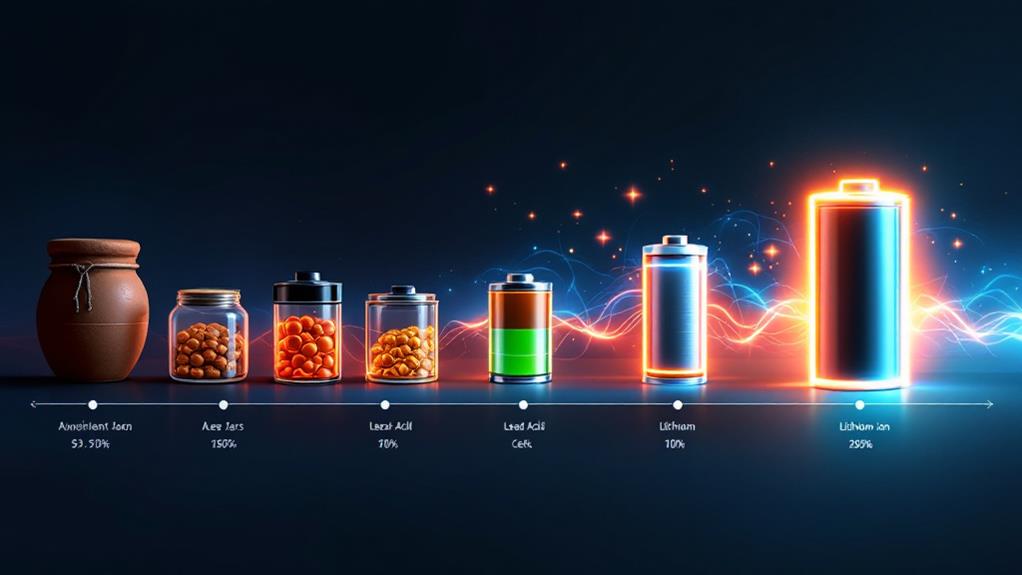The History of Batteries: From Ancient Times to Modern Power Sources

Investigate the fascinating expedition of batteries, essential tools of modern life. You'll be amazed to learn that this adventure starts with ancient civilizations like the makers of the Baghdad Battery, hinting at early electrochemical experimentation. Fast forward to the 1800s, Alessandro Volta's voltaic pile marked the dawn of true batteries, followed by significant developments like the Daniell Cell and Planté's lead-acid battery. The 20th century saw a leap with nickel-cadmium and then the lithium-ion battery, which transformed how we power devices today. As innovation continues, there's more to uncover about these power sources that energize your everyday life.
Early Electrochemical Experiments
In the early days of electrochemistry, scientists initiated groundbreaking experiments that laid the foundation for modern batteries. You might find it fascinating how these pioneers investigated the mysteries of Galvanic cells, which emerged from historical experiments that examined electrochemical theory. By understanding these fundamental principles, they devised primitive batteries that harnessed chemical reactions to store energy.
Imagine yourself in the shoes of Alessandro Volta, one of the key figures in this field. He created the Voltaic Pile, a stack of alternating zinc and copper discs separated by layers of cardboard soaked in saltwater. This creative setup was one of the initial practical Galvanic cells. You'd notice how these chemical reactions between metals and electrolyte solutions facilitated energy storage, providing a continuous flow of electrical current.
These early scientists didn't only create rudimentary power sources but also laid the groundwork for the batteries you rely on today. Their historical experiments paved the way for the evolution of electrochemical theory, helping you understand how energy can be stored and utilized efficiently. By experimenting with primitive batteries, they revealed the potential of chemical reactions to power a rapidly advancing world.
The Mystery of the Baghdad Battery
Picture yourself uncovering an ancient artifact that challenges everything you thought you knew about early technology—the Baghdad Battery. Imagine the thrill as you hold this mysterious object, believed to be over 2,000 years old, in your hands. This intriguing piece of history has left scientists and historians scratching their heads due to its potential function as an early form of energy storage. Found near Baghdad, this artifact consists of a clay jar, a copper cylinder, and an iron rod. Could these components have been used to generate electricity long before the modern battery?
Consider these fascinating aspects:
- Construction: The jar's design suggests it might have been filled with a liquid, possibly an acidic or alkaline solution, to facilitate an electrochemical reaction.
- Purpose: Some speculate it was used for electroplating jewelry, while others propose it had religious or medicinal purposes.
- Mystery: Without written records, the true purpose of the Baghdad Battery remains a subject of debate among scholars.
These ancient artifacts open a window into a world where energy storage might have existed in ways we can't fully comprehend. What other secrets could they hold, waiting to be unveiled?
Volta's Breakthrough Voltaic Pile

As you ponder the mysteries of the Baghdad Battery, imagine stepping into a new phase of exploration with Alessandro Volta's groundbreaking invention, the Voltaic Pile. This remarkable creation marked a crucial moment in the history of batteries, sparking a new period of scientific revelation. Volta's inspiration came from his curiosity about the nature of electricity and the experiments of his predecessors, like Luigi Galvani. Volta sought to understand and harness electricity, leading him to develop a device that would provide a steady flow of electric current.
Using electrochemical principles, Volta stacked alternating layers of zinc and copper discs, separated by pieces of cardboard soaked in saltwater. This cutting-edge setup allowed electrons to flow through the metals and the electrolyte, generating a continuous electric current. The Voltaic Pile was the initial true battery, providing a more reliable and consistent power source than anything that had come before.
In your exploration of Volta's work, you'll see how his invention laid the foundation for modern electrochemical cells. The Voltaic Pile not only advanced scientific understanding but also inspired future advancements, shaping the way we harness and utilize electricity today.
Development of the Daniell Cell
Frequently, scientific progress builds upon the achievements of those who came before, and the development of the Daniell Cell is a perfect example of this. Building on Volta's work, John Frederic Daniell created a more stable and efficient electrochemical cell in 1836. This innovation marked a significant advancement in battery technology, addressing the limitations of the Voltaic Pile, such as its rapid loss of power and hydrogen gas buildup.
The Daniell Cell offered several improvements:
- Enhanced Longevity: Unlike its predecessor, the Daniell Cell provided a more consistent and longer-lasting power source, making it ideal for telegraphy and other emerging technologies.
- Reduced Corrosion: By using a copper sulfate solution and a copper electrode, it minimized the problem of electrode corrosion, which plagued earlier electrochemical cells.
- Improved Efficiency: The introduction of a porous partition between the copper and zinc solutions helped maintain a stable voltage by preventing the mixing of different solutions.
The Invention of the Lead-Acid Battery

In the mid-19th century, the invention of the lead-acid battery marked a revolutionary step in energy storage technology. Invented in 1859 by Gaston Planté, this was the initial rechargeable battery, which was a game-changer. You could now store energy and recharge it, making it incredibly practical for numerous uses. The lead-acid battery's design involved lead dioxide and sponge lead plates submerged in a sulfuric acid solution, which allowed for both discharge and recharge functionality.
One of the significant lead acid advantages is its cost-effectiveness. Compared to other battery types, it's relatively inexpensive to produce, which has contributed to its widespread use. Moreover, lead-acid batteries boast a high surge current, making them ideal for applications requiring a quick burst of power.
In terms of lead acid applications, you'll find these batteries in cars as they're perfect for starting engines. They're also used in uninterruptible power supplies (UPS), providing emergency power during outages. Furthermore, they're prevalent in renewable energy systems, offering backup power storage. Despite newer technologies, the lead-acid battery remains a staple due to its reliability and efficiency in delivering power.
Advancements in Alkaline Batteries
Many notable advancements have been made in alkaline battery technology since their introduction in the mid-20th century. If you're curious about how these changes affect you, let's explore the improvements that make your devices run longer and more efficiently. The core of these advancements lies in the improved understanding and application of alkaline chemistry. By optimizing the chemical reactions within the battery, manufacturers have greatly improved battery longevity, ensuring your gadgets stay powered for extended periods.
Here are three key advancements in alkaline battery technology you should know:
- Increased Energy Density: Modern alkaline batteries hold more energy than earlier versions. This means you get more power without increasing the battery size, making them perfect for compact devices.
- Improved Shelf Life: Thanks to better sealing techniques and superior materials, today's alkaline batteries last longer even when stored. You can stock up without worrying about them losing power.
- Environmental Considerations: Newer designs focus on reducing harmful chemicals, making alkaline batteries safer for the environment while maintaining performance.
The Rise of Lithium-Ion Technology

You'll find lithium-ion technology at the heart of many modern devices, from smartphones to electric vehicles. This technology's rise began in the late 20th century, transforming how we power our world. One of its primary advantages is its high energy density, allowing you to enjoy longer battery life without adding bulk to your gadgets. Whether it's a sleek laptop or a lightweight power tool, lithium-ion batteries provide the punch you need.
Another key lithium advantage is its efficiency. These batteries hold their charge well and recharge quickly, making them incredibly convenient for your fast-paced lifestyle. Plus, they have a lower self-discharge rate compared to older battery types, so your devices are ready whenever you are.
However, it's essential to evaluate the environmental impact. While lithium-ion batteries are more environmentally friendly than their predecessors, they're not without their challenges. Mining lithium and other materials can affect ecosystems, and improper disposal can lead to pollution. But, strides in recycling technologies are helping reduce these effects, making lithium-ion a more sustainable choice. By understanding these aspects, you can appreciate how lithium-ion technology powers your life while being mindful of its footprint.
Future Trends in Battery Innovation
As lithium-ion technology continues to power our modern world, the horizon is already filled with exciting advancements poised to redefine the battery landscape. You're about to witness some groundbreaking innovations that promise to transform how we store and utilize energy. Here's what's coming your way:
- Solid State Batteries: These are set to revolutionize the industry with higher energy density and improved safety over traditional lithium-ion batteries. By using solid electrolytes, they minimize risks of leakage and offer ultra fast charging capabilities.
- Organic Batteries: These eco-friendly power sources are crafted from organic materials, making them a sustainable energy solution. They're not only biodegradable but also potentially more cost-effective, reducing the environmental impact of traditional battery production.
- Grid Storage and Battery Recycling: The future will see upgraded grid storage solutions to stabilize renewable energy sources and smart battery recycling processes. This will guarantee that materials are repurposed efficiently, supporting a circular economy.
These innovations aren't just about improving performance; they're about building a more sustainable future. As energy needs grow, these technologies will help meet demands while minimizing our carbon footprint. Prepare for a new age in battery technology that prioritizes both performance and the planet.



